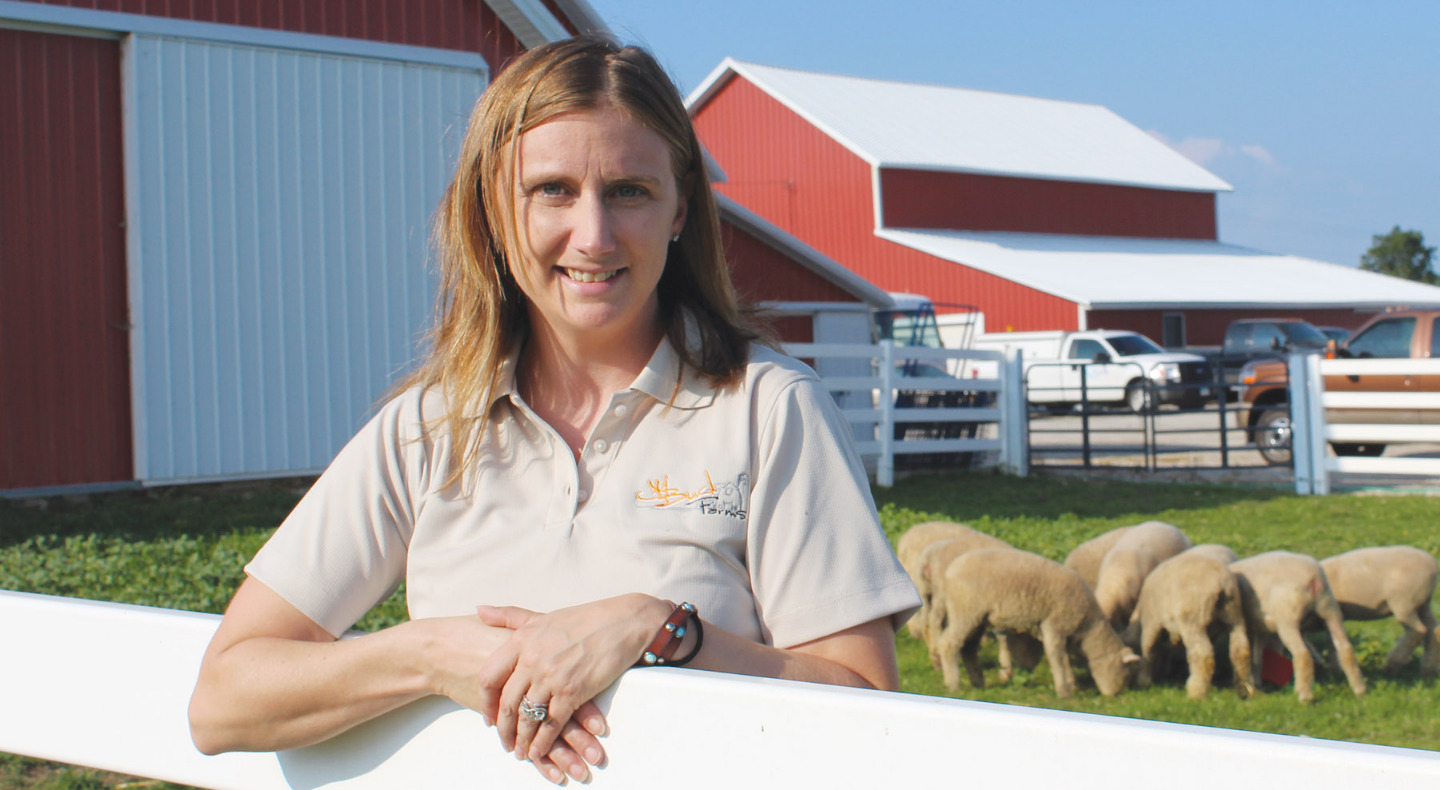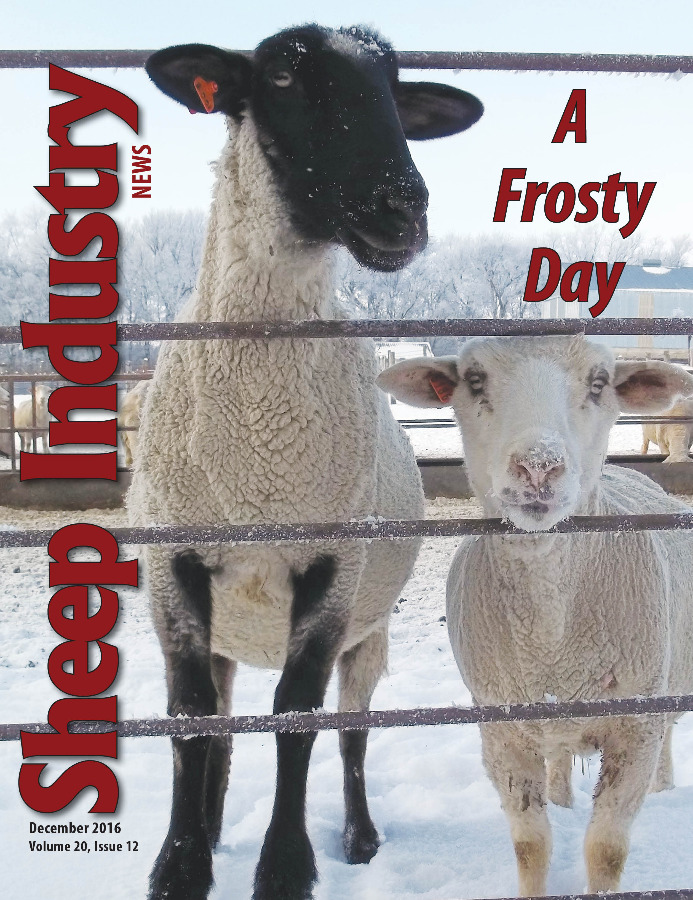Young Entrepreneur: Emily Buck
Emily Buck, Ph.D., was chosen as one of five 2017 Faces of Farming and Ranching by the U.S. Farmers & Ranchers Alliance. While the farmer, sheep producer and college professor (Ohio State University) learned of her selection a few weeks earlier, she was officially introduced as part of the program’s third class in early November at the National Association of Farm Broadcasters Convention in Kansas City, Mo.
 I have been very active in the American Farm Bureau and their leadership programs. Through that, I saw the call for this program and thought it looked like a great opportunity to talk about agriculture and what we’re doing on our farm. There was a paper application process along with a video application we submitted introducing ourselves. I got a bottle lamb that my daughter had named Peep and I took Peep around to different events with consumers to try and start conversations. I put Peep and I in the video, and I guess that got their attention. I was chosen as one of the final eight, and then they came out to the farm to do an interview and video. Based on the interview and popular vote online for the videos, they chose the top five.
I have been very active in the American Farm Bureau and their leadership programs. Through that, I saw the call for this program and thought it looked like a great opportunity to talk about agriculture and what we’re doing on our farm. There was a paper application process along with a video application we submitted introducing ourselves. I got a bottle lamb that my daughter had named Peep and I took Peep around to different events with consumers to try and start conversations. I put Peep and I in the video, and I guess that got their attention. I was chosen as one of the final eight, and then they came out to the farm to do an interview and video. Based on the interview and popular vote online for the videos, they chose the top five.
I grew up on a sheep farm. My parents started with Suffolks. We lived in the city, but my dad had a friend who had Suffolks, and one day he just decided that we were going to get Suffolks and move to the country. As I grew up in 4-H and FFA, I started a flock of Cheviot ewes. By the time I graduated from high school, I had more than 100 ewes. I think it was one of the largest Cheviot flocks in the country for a while. Nobody else is that crazy. As I went to college, my mom transitioned the flock into Bluefaced Leicesters. After graduating from college, I wanted to get back into the sheep. I didn’t think I could convince my husband that Cheviots were a good idea, so I went with Southdowns. I have a flock of about 40 Southdown breeding ewes. I have to keep the flock to about 40 because of my off the farm job and the crops that we deal with, as well.
I did the 4-H and FFA thing and sheep was in my blood. I love the animals and the industry. I worked with Roger High through the years and always had a lot of respect for the Ohio Sheep Improvement Association. So, I knew once I had the income and the ability that I would get back into sheep and farming. I have a daughter, and I want to make sure that she gets to be in the livestock industry and see what is involved in raising animals on a daily basis. For me, it was important to be a part of the sheep industry because I really value the industry and the products that we develop. Hopefully, my daughter will want to keep raising sheep as she gets older.
I’m a faculty member in ag communications, so I teach classes in photography, web production, writing and magazine development. In addition to teaching, I do some advising and some research with social media. My research mostly involves looking at social media and the images we use and talking to consumers and farmers about the best strategies we can use to make this new technology work for agriculture. This new role with USFRA is interesting to me on many levels. Career wise, it’s great for me to see how people are doing things and having the chance to research the role of social media. I know how important it is to share our farm’s story, and if I could get more consumers to eat lamb through my involvement with this program then that would be great. I definitely want to make sure that I talk about lamb, as well as everything else going on at the farm.
What we’ve been told by USFRA is starting Jan. 1, they’re going to be connecting us with different consumer and media groups around the country. We won’t necessarily be talking to ag groups, but going to places like New York, Los Angeles and Boston, places where agriculture isn’t normally in the conversation. This will give us a chance to be in places where we can answer questions that consumers might have about the way we produce food in this country.
The majority of my students do come from an ag background. We’ve seen our numbers increase exponentially in the last couple of years. There are a lot of these kids realizing that there is this disconnect with the consumer, and they want to come into college and find ways to talk about ag. The majority of kids are familiar with social media and are petty tech savvy. There are always people who don’t like technology no matter what generation you’re talking about. But for the majority of our students, social media is really second nature to them. They are very comfortable using it. So in class, it’s trying to show them the different ways to use the technology to reach consumers. I’m in my 30s, and what I see are a lot of people in my generation adapting to the new technology and trying to use it in a way that will help sustain their agricultural lifestyle.
I’m excited to be able to talk about sheep. I’m thankful to ASI for getting the word out about the USFRA voting. It’s great that sheep can be a part of the conversations we’ll be having for the next year. Hopefully, I can convince more people to give lamb a try.


